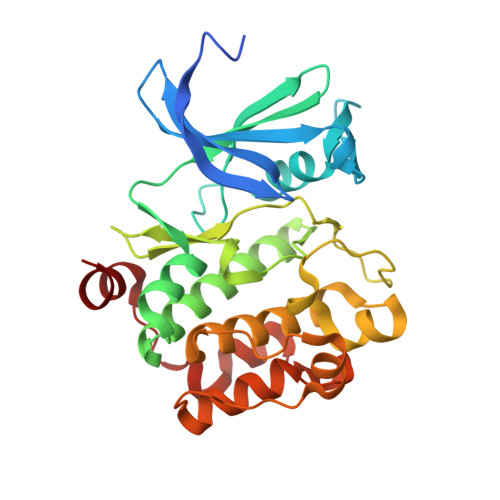Discovery and Optimization of Macrocyclic Quinoxaline-pyrrolo-dihydropiperidinones as Potent Pim-1/2 Kinase Inhibitors.
Cee, V.J., Chavez, F., Herberich, B., Lanman, B.A., Pettus, L.H., Reed, A.B., Wu, B., Wurz, R.P., Andrews, K.L., Chen, J., Hickman, D., Laszlo, J., Lee, M.R., Guerrero, N., Mattson, B.K., Nguyen, Y., Mohr, C., Rex, K., Sastri, C.E., Wang, P., Wu, Q., Wu, T., Xu, Y., Zhou, Y., Winston, J.T., Lipford, J.R., Tasker, A.S., Wang, H.L.(2016) ACS Med Chem Lett 7: 408-412
- PubMed: 27096050
- DOI: https://doi.org/10.1021/acsmedchemlett.5b00403
- Primary Citation of Related Structures:
5EOL - PubMed Abstract:
The identification of Pim-1/2 kinase overexpression in B-cell malignancies suggests that Pim kinase inhibitors will have utility in the treatment of lymphoma, leukemia, and multiple myeloma. Starting from a moderately potent quinoxaline-dihydropyrrolopiperidinone lead, we recognized the potential for macrocyclization and developed a series of 13-membered macrocycles. The structure-activity relationships of the macrocyclic linker were systematically explored, leading to the identification of 9c as a potent, subnanomolar inhibitor of Pim-1 and -2. This molecule also potently inhibited Pim kinase activity in KMS-12-BM, a multiple myeloma cell line with relatively high endogenous levels of Pim-1/2, both in vitro (pBAD IC50 = 25 nM) and in vivo (pBAD EC50 = 30 nM, unbound), and a 100 mg/kg daily dose was found to completely arrest the growth of KMS-12-BM xenografts in mice.
- Amgen Inc. , One Amgen Center Drive, Thousand Oaks, California 91320-1799, United States.
Organizational Affiliation:


















